| دينار سوداني (Arabic) | |
|---|---|
| ISO 4217 | |
| Code | SDD |
| Unit | |
| Symbol | SD |
| Denominations | |
| Banknotes | |
| Freq. used | SD 100, SD 200, SD 500, SD 1,000, SD 2,000, SD 5,000, SD 10,000 |
| Rarely used | SD 5, SD 10, SD 25, SD 50 |
| Coins | SD 1, SD 2, SD 5, SD 10, SD 20 and SD 50 |
| Demographics | |
| User(s) | None (previously Sudan) |
| Issuance | |
| Central bank | Bank of Sudan |
| Website | www |
| Valuation | |
| Inflation | 9% |
| Source | The World Factbook , 2005 est. |
| This infobox shows the latest status before this currency was rendered obsolete. | |
The dinar was the currency of Sudan between 1992 and 2007. Its ISO 4217 code was "SDD" and had no official subdivision. It replaced the first Sudanese pound and, in turn, was replaced by the second Sudanese pound.
The dinar replaced the first Sudanese pound (SDP) on June 8, 1992, at a rate of SD 1 = £S.10. On January 10, 2007, a second Sudanese pound (SDG) was introduced at a rate of 1 pound = 100 dinars. According to the Bank of Sudan, the dinar was to have stopped circulating after a six-month transitional period. The pound and the dinar were to be accepted as legal currency side by side during the six-month period but cheques would be cashed in pounds from the commercial banks. The Bank of Sudan began distributing the new currency to commercial banks and sent consignments of banknotes to the south in 2007. [1] This second Sudanese pound became the only legal tender as of July 1, 2007.
Coins were minted in denominations of SD 1⁄4, SD 1⁄2, SD 1, SD 2, SD 5, SD 10, SD 20 and SD 50 (the two smallest denominations appear to have been shelved before being issued). A reduction in size took place, with the 2001-03 coins being generally smaller than the 1994-99 coins. A source [2] indicates that bi-metallic SD 50 and SD 100 coins were planned but that this plan was shelved because of the introduction of the second pound. See below for more detail.
Banknotes were issued in denominations of SD 5, SD 10, SD 25, SD 50, SD 100, SD 200, SD 500, SD 1,000, SD 2,000 and SD 5,000. The lowest three denominations were withdrawn on 1 January 2000 due to a concern that well-used notes could spread disease. [2] Old pound notes also circulated alongside dinar notes. [2]
Rate against US$1995–2004. (See historical rates)
The Kwacha is the currency of Zambia. It is subdivided into 100 Ngwee.

The Iraqi dinar is the currency of Iraq. It is issued by the Central Bank of Iraq and is subdivided into 1,000 fils (فلس), although inflation has rendered the fils obsolete since 1990. On 7 February 2023, the exchange rate with the US Dollar was US$1 = 1300 dinars.

Legal tender is a form of money that courts of law are required to recognize as satisfactory payment for any monetary debt. Each jurisdiction determines what is legal tender, but essentially it is anything which when offered ("tendered") in payment of a debt extinguishes the debt. There is no obligation on the creditor to accept the tendered payment, but the act of tendering the payment in legal tender discharges the debt.

The dinar is the official currency of Libya. The dinar is divided into 1,000 dirhams (درهم). It is issued by the Central Bank of Libya, which also supervises the banking system and regulates credit.
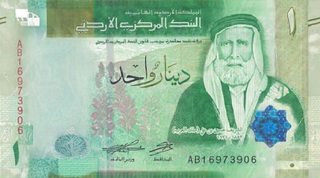
The Jordanian dinar has been the currency of Jordan since 1950. The dinar is divided into 100 qirsh or 1000 fulus. It is pegged to the US dollar.
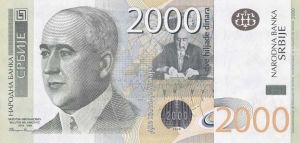
The dinar is the currency of Serbia. The dinar was first used in Serbia in medieval times, its earliest use dating back to 1214. The dinar was reintroduced as the official Serbian currency by Prince Mihailo Obrenović in the 19th century. One dinar was formerly subdivided into 100 para.

The lira or pound was the currency of Malta from 1972 until 31 December 2007. One lira was divided into 100 cents, each of 10 mils. After 1986 the lira was abbreviated as Lm, although the original £M sign continued to be used unofficially. In English the currency was still frequently called the pound even after its official English language name was changed to lira.
The pound is the currency of Guernsey. Since 1921, Guernsey has been in currency union with the United Kingdom and the Guernsey pound is not a separate currency but is a local issue of sterling banknotes and coins, in a similar way to the banknotes issued in Scotland, England and Northern Ireland. It can be exchanged at par with other sterling coinage and notes.

The Egyptian pound is the official currency of Egypt. It is divided into 100 piastres, or ersh, or 1,000 milliemes.
The pound is the currency of Gibraltar. It is pegged to – and exchangeable with – sterling at par value. Coins and banknotes of the Gibraltar pound are issued by the Government of Gibraltar.

The dalasi is the currency of the Gambia that was adopted in 1971. It is subdivided into 100 bututs. It replaced the Gambian pound at a rate of 1 pound = 5 dalasis, i.e. 1 dalasi = 0.2 pound = 4 shillings.

The dinar is the currency of Bahrain. It is divided into 1000 fils (فلس). The Bahraini dinar is abbreviated د.ب (Arabic) or BD (Latin). It is usually represented with three decimal places denoting the fils.

The dinar is the national currency of Tunisia. It is subdivided into 1000 milim or millimes (ملّيم). The abbreviation DT is often used in Tunisia, although writing "dinar" after the amount is also acceptable ; the abbreviation TD is also mentioned in a few places, but is less frequently used, given the common use of the French language in Tunisia, and the French derivation of DT.
The Omani rial is the currency of Oman. It is divided into 1000 baisa.

The East African shilling was the sterling unit of account in British-controlled areas of East Africa from 1921 until 1969. It was issued by the East African Currency Board. It is also the proposed name for a common currency that the East African Community plans to introduce.
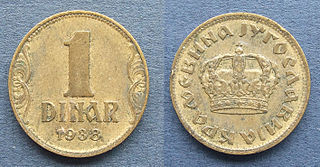
The dinar was the currency of the three Yugoslav states: the Kingdom of Yugoslavia, the Socialist Federal Republic of Yugoslavia, and the Federal Republic of Yugoslavia between 1918 and 2003. The dinar was subdivided into 100 para.
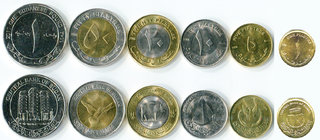
The Sudanese pound is the currency of the Republic of the Sudan. The pound is divided into 100 piastres. It is issued by the Central Bank of Sudan.
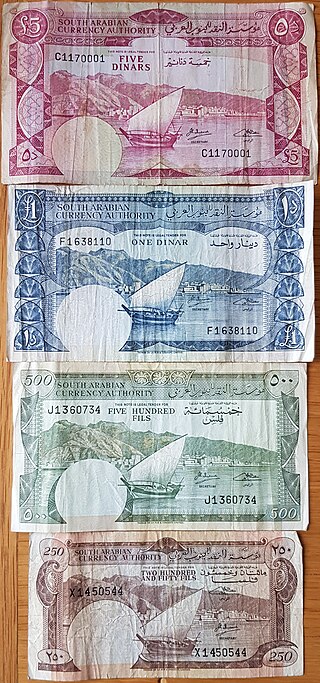
The dinar was the currency of South Arabia and then South Yemen between 1965 and 1990. It was subdivided into 1000 fils (فلس). After Yemen's monetary unification on 1 July 1990, it was one of the two official currencies used in Yemen Republic until 11 June 1996.

The Palestine pound was the currency of the British Mandate of Palestine from 1 November 1927 to 14 May 1948, and of the State of Israel between 15 May 1948 and 23 June 1952, when it was replaced with the Israeli lira. The Palestine pound was also the currency of Transjordan until 1949 when it was replaced by the Jordanian dinar, and remained in usage in the West Bank of Jordan until 1950. In the Gaza Strip, the Palestine pound continued to circulate until April 1951, when it was replaced by the Egyptian pound.

The South Sudanese pound is the currency of the Republic of South Sudan. It is subdivided into 100 piasters. It was approved by the Southern Sudan Legislative Assembly before secession on 9 July 2011 from Sudan.
| Preceded by: 1st Sudanese pound Reason: inflation Ratio: 1 dinar = 10 (1st) pounds | Currency of Northern Sudan 1992 – January, 2007 | Succeeded by: 2nd Sudanese pound Reason: inflation and currency unification (peace treaty) Ratio: 1 (2nd) dinar = 100 piastres |